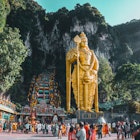With mobile phones that feature sophisticated cameras in the hands of most travelers, taking photos has never been easier. But if you want to level up your Instagram game with quality images beyond the typical smartphone fare, follow our tips for picking and packing a travel photography kit.

Selecting your system
There’s a perfect setup for every kind of adventure – pack according to the likeliest scenarios you’ll encounter and stay mindful of factors like climate, seasonality, the local culture and the length of your trip. Pick the proper camera system for yourself – think about features and controls you’ll need and get familiar with them long before you hit the road.
Bodies
DSLRs by big brands like Canon and Nikon have long been the go-to brands for serious shooters, but lighter and smaller mirrorless options are gaining traction with hobbyist and professional photographers alike. Mirrorless systems like the Fujifilm X Series (fujifilm-x.com) or Sony Alpha (alphauniverse.com) have the advantage of being extremely compact– half the size of traditional DSLRs – and many models host interchangeable lenses for an image quality that’s superior to point-and-shoot cameras.
An important thing to note when selecting a camera body is its image sensor size (which varies by model and manufacturer) and how it impacts the camera’s field of view. This is known as crop factor – if the same lens is used on two cameras with different image sensor sizes, the one with the smaller sensor will show a smaller, ‘cropped’ area of the scene.

Lenses
Lens selection depends on the nature of the trip and your planned itinerary. In general, opt for wide angle lenses (35mm and lower) for landscapes and telephoto lengths (70mm or higher) for shooting faraway subjects. Also consider crop factor when picking lenses – ones made for mirrorless systems will come in different sizes that are equivalent to standard DSLR lens focal lengths.
A versatile zoom lens that shoots from wide angle to telephoto provides enough range to capture a variety of travel scenes and situations. On the other hand, prime (fixed focal length) lenses are often more compact and an overall better choice for their faster optics and broader aperture settings. You can’t zoom with these lenses, which can be a good thing – it forces you to interact more with the environment as you work toward that perfect shot.
Select primes that cover a range of bases: 50mm is a popular ‘standard’ lens with a field of view that closely resembles the human eye; 35mm is a good wide length for landscapes, street scenes and architecture; 85mm is a solid choice for portraiture. When shooting wildlife, pick primes between 300mm and 600mm. Because animals tend to move quickly, a telephoto zoom lens ranging from 70mm to 400mm is also a good option.
Filters
Thanks to digital editing, the use of filters on camera lenses to modify an image isn’t as necessary as it used to be, but there are still a couple of useful ones. UV filters cut atmospheric haze and protect your lens (many opt to leave them on at all times). Circular polarizer filters are good landscapes; they can boost color saturation, reduce glare and cut reflections on water or glass.
Flash
With the world as your studio, it’s typical to rely on available light when shooting your travels. That said, a flash can be beneficial when the ambient light isn’t sufficient indoors or when you're trying to capture quickly-moving subjects outdoors at night. Luckily, hot shoe mount flash units are compact enough to pack with ease. For travel photography, use ‘through the lens’ (TTL) metering rather than manual flash for travel photography. The unit to select depends on the camera’s brand, as most are only compatible with specific models.

Bag basics
Luggage is a significant consideration for anybody who travels, but for the itinerant photographer, it’s key that the form fits the function. A camera bag’s style and capacity should suit not only your gear (an expensive investment, after all) but also the nature of the trip.
Spring for a bag with just enough room for your essentials so you won’t be tempted to overpack. Size and weight are important not only for airline carry-on restrictions, but also because the burden of toting cumbersome luggage can get annoying and painful quickly. Save your back and shoulders by selecting something comfortable enough to carry for an extended period of time. Backpacks are best for hands-free movement, and messenger styles allow easy access to your gear.
Ensure it has well-made protective features like padded, Velcro-adjustable compartments and waterproofing elements to help safeguard your gear. Typical bags (made from black nylon or polyester fabric) can be conspicuous – try one of these trip-specific designs to keep a low profile:
Best for adrenaline junkies
The MindShift Gear (mindshiftgear.com) Rotation 180 Series backpacks are made for photographers with a passion for high-octane adventure. Their rotating belt packs allow quick access to your camera when you see a shot, and safe stowing when you need to focus on the adventure in front of you – all without ever taking the backpack off. There’s ample room for essentials like snacks, extra layers of clothing and a hydration bladder.
Best for urban-to-outdoor adventures
For city slickers who regularly heed the call of the wild, the Langly (langly.co) Messenger Tote or Alpha Pro Backpack are ideal for seamless style that fits into photography settings from bustling urban centers to cozy campsites. Removable and adjustable inserts allow for customizable configuration. Bonus: you can match your bag with one of their sturdy and stylish camera straps or memory card and battery holders.
Best for style-savvy snappers
Fashion-conscious traveling photographers don’t have to sacrifice style for function. Beautifully-crafted bags like the Claremont by Lo & Sons (loandsons.com) are ideal for those who prefer to keep their kits covert. The comfortable cross-body looks like a chic satchel from the outside; inside are ideal features to protectively transport your gear.

Other necessities
With your camera picked and packed, get the most out of it by bringing the right accessories to help you get the shot in any situation.
Travel tripods
Tripods are necessary if you plan to do any kind of long exposures. There are compact models that provide steady support while minimizing weight and bulk. Try one from the Gitzo Traveler series (gitzo.us) or Joby’s GorillaPods (joby.com), whose flexible, rubberized segments can be set up like a traditional tripod or wrapped around available structures like trees, light poles or furniture.
Mind mother nature
Protect your camera from any kind of elemental forces (sand, snow, dust, salt spray) with a rain cover. Choices run the gamut of price point and sizes – disposable plastic covers can be picked up for under $10 from a photo supply shop. High-tech versions include the ThinkTank Hydrophobia (thinktankphoto.com) or Aquatech (aquatech.net) Sport Shield.
Power up
If there’s one thing to overpack in your kit, it’s batteries – especially if you’re shooting in situations where it’ll be tough to find a power source and recharge. The Watson (poweredbywatson.com) Duo LCD Charger, available for different battery styles, allows two batteries to charge at once. If you’re carrying different types of batteries, Watson’s Compact AC/DC Charger has interchangeable plates so you can save space and charge them all with one device.
Memory cards and storage
Bring at least two or three memory cards (in case one gets corrupted) and a card reader to regularly transfer your images off your camera. Transcend (transcend-info.com) has compact readers for multiple card formats to transfer and backup images onto a laptop. If you can’t bring a laptop with you, you can offload images onto an external hard drive using a portable memory backup device – the HyperDrive ColorSpace UDMA2 (hypershop.com) and Nexto DI (nextodi.com) ND2901 allow you to review images and single out selects on the go.
Cleaning supplies
Keep your camera clean with a squeeze-bulb blower, retractable brush (never touch the bristles), and microfiber lens cloth or pre-dampened lens wipes. If you choose to clean your camera’s sensor yourself, Photographic Solutions (photosol.com) Sensor Swabs are small enough to pack and remove dust from quickly and easily.
Remote shutter release
Just because you’re not shooting with a smartphone doesn’t mean you can’t take selfies – remote shutter release controllers are great for setting up self-portraits and help eliminate vibrations caused by physically pressing the camera’s shutter release during long exposures. Most brands make models specifically for your camera, but Foto&Tech (fotoandtech.com) sells good, cheap versions for nearly all makes and models. Also see if your camera brand has an app to turn your smartphone into a remote controller – that’s one less thing to pack.











